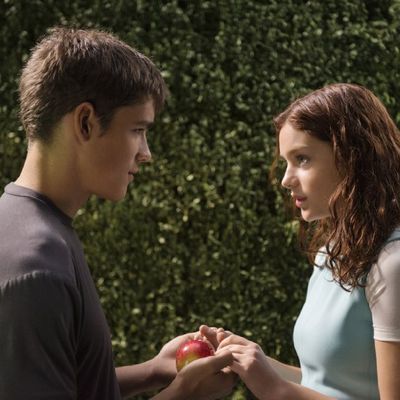
Philip NoyceÔÇÖs film adaptation of The Giver, Lois LowryÔÇÖs middle-school war horse of a classic, at first presents a genuinely sad portrait of an oppressive, joyless future. But its ultimate vision of humanity itself ÔÇö of all the things that this world is missing ÔÇö is a crushingly generic one. Add to that some painfully lifeless action, and you wind up with a movie that plays like a low-rent LoganÔÇÖs Run crossed with a UNICEF commercial.
But, as noted, it starts off pretty well. Theres a sad idealism to the emotional poverty of this sci-fi world, known as the Community, an antiseptic land where everybodys mildly happy and mildly kind and mildly standoffish. The good stuff that makes life worth living is gone, but so too is the bad stuff. Fear, envy, hate  these werent words so much as sounds, the teenage protagonist Jonas (Brenton Thwaites) tells us in voice-over. This civilizations rules sound like they could belong in a mental asylum. (Among them: Dont lie, Take your medication, Obey the curfew, and, my favorite, Use precise language.) Noyce, who has never been a visually fussy director, shoots these early scenes in black and white and steers clear of fancy camera moves or showy compositions. Its as if hes absorbed the heads-down, never-stray dogma of the Community.
Jonas, however, sees more. He sees occasional bursts of color, particularly in his beautiful best friend FionaÔÇÖs (Odeya Rush) red hair, and he expresses an earnest wonderment at the world around him. We know all this will get him in trouble. On the annual Ceremony of Advancement, a kind of Community-wide graduation ceremony, everyone coming of age is given their job and purpose in life, in solemn, ominously specific language so beloved of dystopias. (ÔÇ£No. 2, Ross. Instructor of the Middles. Thank you for your childhood.ÔÇØ) But Jonas is singled out because he doesnÔÇÖt have ordinary talents. He has, as the Chief Elder (Meryl Streep) puts it, ÔÇ£the capacity to see beyond.ÔÇØ HeÔÇÖs given a sacred duty to become the CommunityÔÇÖs next Receiver of Memory, which means that he will keep alive ÔÇö and keep to himself ÔÇö the legacy of knowledge and humanism and history that the Community has so consciously purged.
To obtain this secret knowledge, Jonas goes to a house perched on the edge of a cliff and meets the current Receiver (Jeff Bridges). The Receiver now becomes the Giver, (yes, I am chuckling as I write those words) and transmits memories to Jonas of color, light, children laughing, weddings, whirling dervishes, poverty, hunger, disease, and war┬áÔÇö ÔÇ£the secret history of the world, when things were different, when there was more.ÔÇØ This transfer, weÔÇÖre told, can be dangerous stuff. Ten years ago, the Giver tried it with another Receiver-in-training, a girl named Rosemary (Taylor Swift, in a cameo), and things did not go well. They donÔÇÖt exactly go well this time, either. Jonas, both troubled and enchanted, begins to ask questions.
The first half of The Giver works in part because the movies very concept turns liabilities into virtues. The actors stiffness, the blandly expository dialogue, the antiseptic imagery  it all makes sense in a world thats been purged of emotion, or uncertainty, or secrets. This film adaptation was reportedly a dream project for Jeff Bridges, and his gruff performance as the Giver cuts through the antiseptic nonsense: The actor is clearly enjoying playing the only recognizable human in this dull place, and his characters contempt for this world mirrors our own. Meanwhile, Streep conveys a cool, prim practicality as the Chief Elder, the domineering matriarch of this society. But despite a couple of fleeting moments of humanity, you start to sense that the largely one-note role isnt worth the presence of such a giant. You keep expecting her to do more, for the role to grow and justify her casting, but the very opposite happens: As the story advances, she seems less and less threatening and consequential. Really, it could be anybody playing her.
Which brings us to some of what ails The Giver. At first, weÔÇÖre intrigued by the little flashes of color and fleeting joy, and even pain, that the Giver transmits to Jonas. But as we get more and more of such passages, they begin to feel like increasingly cheap attempts at emotional resonance, manipulative in the crassest way: village dances and weddings and shots of kids with terminal illnesses and sick old men and babies being born, stuff designed to milk maximum emotion in as brief a time as possible. You might even be moved by these little montages of stock footage, but they lose their value the more we see of them. The more the film relies on them, the more you realize that itÔÇÖs running out of ideas.
The filmmakersÔÇÖ desperation becomes even more palpable as the film devolves into a lame chase flick. I havenÔÇÖt read LowryÔÇÖs novel, so I donÔÇÖt know how faithful the movie is. And itÔÇÖs hard to discuss some of the filmÔÇÖs more inchoate elements without getting into heavily spoiler-laden territory. But suffice it to say that I found what I was watching to be increasingly rushed and ill-defined, governed by rules that donÔÇÖt quite make sense ÔÇö even in the vaguely mystical, few-degrees-removed reality of this film. Maybe the book explains it better. Or maybe a sequel will reveal all. Movies, however, should be able to stand on their own. And The Giver starts off promisingly, but it loses its sense of purpose.


